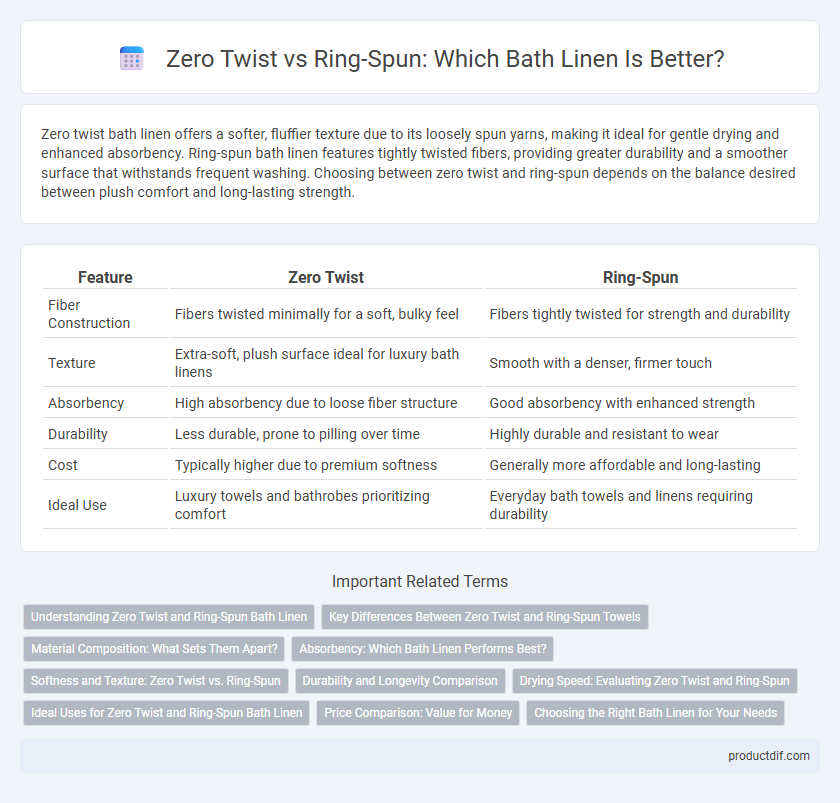Zero twist bath linen offers a softer, fluffier texture due to its loosely spun yarns, making it ideal for gentle drying and enhanced absorbency. Ring-spun bath linen features tightly twisted fibers, providing greater durability and a smoother surface that withstands frequent washing. Choosing between zero twist and ring-spun depends on the balance desired between plush comfort and long-lasting strength.
Table of Comparison
| Feature | Zero Twist | Ring-Spun |
|---|---|---|
| Fiber Construction | Fibers twisted minimally for a soft, bulky feel | Fibers tightly twisted for strength and durability |
| Texture | Extra-soft, plush surface ideal for luxury bath linens | Smooth with a denser, firmer touch |
| Absorbency | High absorbency due to loose fiber structure | Good absorbency with enhanced strength |
| Durability | Less durable, prone to pilling over time | Highly durable and resistant to wear |
| Cost | Typically higher due to premium softness | Generally more affordable and long-lasting |
| Ideal Use | Luxury towels and bathrobes prioritizing comfort | Everyday bath towels and linens requiring durability |
Understanding Zero Twist and Ring-Spun Bath Linen
Zero twist bath linen offers exceptional softness and absorbency due to fibers being gently spun without added tension, resulting in plumper yarns ideal for luxury towels. Ring-spun bath linen, crafted through tightly twisted fibers, provides enhanced durability and strength, making it suitable for everyday use with improved longevity. Selecting between zero twist and ring-spun depends on the desired balance of softness versus durability in bath linens.
Key Differences Between Zero Twist and Ring-Spun Towels
Zero twist towels feature unbound cotton fibers twisted minimally or not at all, resulting in a ultra-soft, plush texture that maximizes absorbency but can be less durable over time. Ring-spun towels undergo a process where fibers are tightly twisted and spun into a strong yarn, providing enhanced durability, resistance to pilling, and a smoother surface with moderate softness. Key differences revolve around texture softness and longevity, with zero twist emphasizing plush comfort and ring-spun prioritizing strength and fabric resilience.
Material Composition: What Sets Them Apart?
Zero twist bath linen features fibers that are tightly twisted only once, creating a softer and more absorbent fabric due to less tension in the yarns. Ring-spun bath linen, made by continuously twisting and thinning the fibers, results in a stronger and more durable fabric with a smoother texture. The key difference lies in material composition: zero twist emphasizes plushness using loosely twisted cotton, while ring-spun combines tightly twisted fibers for resilience and longevity.
Absorbency: Which Bath Linen Performs Best?
Zero twist bath linen features loosely spun fibers that create more air pockets, enhancing moisture absorption and offering superior absorbency compared to ring-spun cotton. Ring-spun bath linens, while softer and more durable due to tightly twisted fibers, generally absorb moisture slower and hold less liquid than zero twist towels. Choosing zero twist towels optimizes quick drying and maximum water absorption, making them ideal for bath linen focused on performance.
Softness and Texture: Zero Twist vs. Ring-Spun
Zero twist bath linen offers exceptional softness due to its loosely spun yarn, creating a plush texture that enhances comfort and absorbency. Ring-spun yarn, while more durable and dense, provides a firmer feel with a smoother surface, making it less fluffy but stronger over time. Choosing zero twist ensures a luxuriously soft touch ideal for sensitive skin, whereas ring-spun balances softness with everyday resilience.
Durability and Longevity Comparison
Zero twist bath linens offer enhanced durability due to their tightly wound fibers that resist fraying and maintain structural integrity over extended use. Ring-spun bath linens, while softer and smoother, may experience faster wear and thinning because of their looser fiber arrangement. The longevity of zero twist linens typically exceeds ring-spun equivalents, making them a superior choice for heavy-duty bath towel applications.
Drying Speed: Evaluating Zero Twist and Ring-Spun
Zero twist bath linens typically dry faster than ring-spun variants due to their looser yarn structure, which promotes better air circulation and moisture evaporation. Ring-spun fabrics, characterized by tighter, more compact fibers, retain moisture longer, resulting in slower drying times. Choosing zero twist towels can enhance drying efficiency, especially in humid environments or frequent-use scenarios.
Ideal Uses for Zero Twist and Ring-Spun Bath Linen
Zero twist bath linen offers exceptional softness and plushness, making it ideal for luxury towels and bathrobes that prioritize comfort and absorbency. Ring-spun bath linen provides enhanced durability and strength, perfect for high-traffic environments such as hotels and spas where frequent washing occurs. Choosing zero twist linen enhances the tactile experience, while ring-spun linen ensures longevity under rigorous use.
Price Comparison: Value for Money
Zero twist bath linen offers exceptional softness at a generally lower price point compared to ring-spun fabric, making it a cost-effective choice for budget-conscious consumers. Ring-spun bath linens tend to be more durable and luxurious, reflected in their higher price, but the added expense translates into longer-lasting quality and better overall value. Evaluating the balance between initial cost and product longevity is crucial when determining the true value for money in bath linen purchases.
Choosing the Right Bath Linen for Your Needs
Zero twist bath linen offers superior softness and absorbency due to its loosely twisted yarns, making it ideal for those seeking luxurious comfort and quick drying. Ring-spun bath linen provides enhanced durability and strength, perfect for heavy use and long-lasting performance. Selecting between zero twist and ring-spun depends on whether softness or resilience is your priority in bath linen.
Zero twist vs ring-spun Infographic

 productdif.com
productdif.com